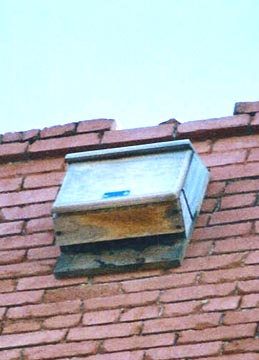
   |
 |
|
|
Why House Bats?Bats have long been maligned by humans -- a taboo, a creature to be shunned. These little furry animals that fly seemed to be half-bird, half-mammal, and looked ugly. But today they are being given their proper recognition as valuable to mankind in the ecological system. Many plants, such as bananas and the endangered saguaro cactus, are dependent upon bats for pollination because they bloom at night. Bats are also responsible for 95% of the reforestation of the tropical rain forests through their dispersal of seeds. Their immediate appeal to most people is their enormous capacity for consuming insects. A nocturnal animal, the bat eats when the insects are out, in contrast to birds, which eat during the day. Some bat species consume half their weight in a night -- as many as 600 or more gnat-sized insects an hour! A single little brown bat (Myotis lucifugas) or big brown bat (Eptesicus fuscus), some of the most abundant and widespread bats in North America, can eat 3,000 to 7,000 mosquitoes each night, and a bat can live to be 20 years old. That's a pretty effective insecticide, especially when you consider that it doesn't poison other creatures or make holes in the ozone layer! Truth About BatsBats are misunderstood creatures that are generally quite harmless to people. They do not become tangled in your hair, nor do they attack humans. Contrary to misconceptions, disease transmission from bats to people is easily avoided. Never handle bats and the odds of being harmed will be extremely remote. "In more than four decades, public health records indicate that only 16 people in the United States and Canada have died of bat-borne diseases... Placed in perspective, this means that the odds of anyone dying of a disease from a bat are much less than one in a million. In contrast, in the United States alone more than 10 people die annually from dog attacks, not to mention dog- and cat-transmitted diseases." - Dr. Merlin D. Tuttle, "America's Neighborhood Bats," University of Texas Press, Austin, 1988. In contrast, several children in a million are likely to die each year from encephalitis contracted through a mosquito bite. In the Orient these gentle animals are symbols of good luck, long life and happiness. They are meticulous in their grooming, spending a fair part of the day and night combing and grooming their fur. When bats fly, they navigate by means of an sophisticated echolocation system. The bat sends out signals of sound energy, which are reflected back, giving it the location of an object as well as its texture and other characteristics. They can avoid a single human hair with extreme accuracy, even in total darkness, giving lie to the myth that bats are blind. Bat Housing CrunchBats are feeling the
housing crunch as much as people, with their favorite old hollow trees, barns,
and old houses disappearing. For this reason many bats are choosing bat
houses as permanent roosting sites. In order for bat houses to be successful they need to meet specific criteria, such as, narrow crevices at the bottom for bats to enter and screened or rough surfaces inside for them to hold onto. A bat house should be hung at least 10 to 15 feet above the ground, sheltered from the wind, and unobstructed by obstacles to flying, such as power lines and tree branches. Bat houses located near a source of water, especially a marsh, lake or stream, are most likely to attract bats, as this habitat attracts insects and provides a plentiful food supply for the bats. To keep the interior very warm, place the house on the side of a building or tree which receives several hours of morning or afternoon sun (100-110 degrees F is required by nursery colonies). If you are located in a cooler climate you may want to add tar paper or dark colored shingles to the bat house roof to help warm the house. If you are located in a warmer climate the bat house can be painted a beige or tan color using latex pain, or mounted as is. The pine wood will weather nicely to an attractive silver gray color which blends well with outdoor environments. During winter months bats living in Canada and the northern two-thirds of the US migrate south or to nearby caves for a period of hibernation, as most bat species cannot survive subfreezing temperatures. ConservationBats are in need of protection if they are to survive. They have proven themselves as valuable members of our ecosystem, and we must increase the awareness of people who have the ability to protect or to destroy these little creatures. Bats are declining, world-wide, at an alarming rate, due to human misunderstanding. They have typically only one offspring per year, making their comeback slow and in need of our help. Coveside Conservation Products supports the Bat World Sanctuary and Bat Conservation International, a nonprofit organizations dedicated to educating the public about these beneficial animals and helping to conserve them. Coveside's Bat HousesThe bat houses made by Coveside Conservation Products are handcrafted of select, kiln-dried eastern white pine for durability, attractiveness, and insulation qualities. The walls are thick to keep the interior warm. They are rough-sawn to provide a surface for the bats to hang onto. Inside are several partitions, because bats like narrow spaces, and this allows more surface room for roosting bats. The houses are open at the bottom to eliminate the need for cleaning, and to prevent birds from nesting in the house.
Do bats transmit the West Nile Virus? According to Bat Conservation International, bats are "dead-end hosts" for the West Nile Virus. This means that mosquitoes can infect bats, but bats do not transmit the virus back to mosquitoes. Since the virus is transmitted to people by infected mosquitoes, bats do not transmit the West Nile Virus. Because bats are huge consumers of insects, bat houses can aid in the control of mosquitoes. Therefore, installing bat houses can help to reduce the threat of West Nile Virus.
|
 Bat House
Bat House
Description: 7/8" Inland Red Cedar for long lasting outdoor use. All screwed construction using weather-resistant plated deck screws and fully routed edges. Constructed in accordance with "The Bat House Builders Handbook" Dimensions: 16-3/4" L x 4" W x 28-3/4" H  |
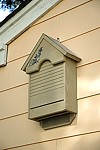 Heartwood Bat Haven
Heartwood Bat Haven
Did you know that many bats eat their weight in insects at night? These valuable creatures provide a great service to our eco-system. It's only right that we provide them with a haven like this: Warm, watertight, with galvanized, corrugated roof, two mesh-covered living quarters and bottom landing pad. Room for up to 48; metal bat applique gives a cheery welcome! Dimensions: 5" x 14" x 22"  |
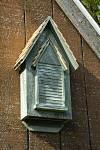 Heartwood Victorian Bat House
Heartwood Victorian Bat House
Forget the myth: bats aren't blind; they enjoy the use of all five senses. Another sense--the sense of style, both the bats and yours--will be delighted by this Victorian gem. Horizontal siding on the front panel provides a strategic counterpoint to steeply pitched hand-shingled cypress roof with copper trim. Divided living quarters and a landing pad at the base make this house as functional as it is beautiful. Ready to mount on a pole, building or tree. Dimensions: 6" x 15" x 30"  |
 Recycled Bat House
Recycled Bat House
Description: Large bat house is constructed out of dark brown recycled poly-lumber for warmth. Lifetime warranty. Dimensions: 13-1/2" X 2-3/4" X 27-1/2"   |
 Coveside "BAT" Chelor Pad
Coveside "BAT" Chelor Pad
Houses up to 30 bats in a single chamber. Features include a large screened landing pad, roughened interior surface and an echolocation slot. Designed for cooler locations preferred by solitary males, but also suitable for a small nursing colony. (20"h x 10"w x 3"d) |
 Coveside Bat Beacon
Coveside Bat Beacon
This easy-to-mount bat house is designed to fit on a standard purple martin pole. With three chambers and an attic, it provides an ideal free-standing habitat for establishing a bat colony. Have any bats taken up residency? The purple martin pole makes lowering easy and the side opens for convenient inspection.(25"h x 8"w x 7-1/2"d) |
 Coveside Bat Condominium
Coveside Bat Condominium
This best seller accomodates over 50 bats and is ideal for a nursing colony. The vertical house contains 4 chambers and can be easily mounted by a hanger on a building or a tree. (19"h x 9-1/2"w x 7-1/2"d) |
 Coveside Bat House Kit
Coveside Bat House Kit
This top seller features a single chamber which will hold up to 20 bats. Similar in design to the "BAT"chelor Pad, but smaller. Features an extended landing pad and an interior covered with screening to provide bats with a maximum foothold. Also includes echolocation slot to help the bats locate the cavity. Designed to be an educational tool for youngsters, and adults alike. It comes with easy-to-follow instructions and information about bats. (16"h x 8"w x 3-3/4"d) |
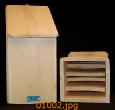 Coveside Bat Mansion
Coveside Bat Mansion
Houses several hundred bats in five chambers plus an attic, which provides for greater temperature stability. Bats seek most comfortable temperture by moving up or down inside the house. A popular house because of its large capacity. (25"h x 11"w x 11"d) |
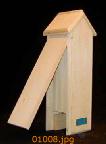 Coveside Bat Tower
Coveside Bat Tower
Latest research indicates that the most successful bat houses are mounted on buildings or are free-standing. The innovative bat tower mounts directly on a 4x4 post. The post actually becomes the landing platform, and from there bats climb into the house. The four internal chambers and attic provide for multiple roosting opportunities. In addition, the side opens to quell the curiosity of the serious "bat-o-phile." (Picture shows house with door partially opened.). (23"h x 6-3/4"w x 7"d) |
 Coveside Large Sunshine's Bat House
Coveside Large Sunshine's Bat House
This special house was designed by Amanda Lollar, who rescued and rehabilitated a little bat named "Sunshine" and then wrote a book about her. Her field testing of many of these houses indicates that bats are readily attracted to and occupy this style. With two chambers and an open slot at the bottom, this abode is suitable for all species of small, insectivorous bats. Features include a screened landing platform, roughened interior surface and echolocation slots on the sides to help bats locate the hollow cavity. Can accomodate 100, 200 or 300 in three different sizes (small, medium and large). (18"h x 24"w x 6-1/2"d) |
 Coveside Mini Bat House
Coveside Mini Bat House
House a few bats in this small version of the "BAT"chelor Pad. Comes complete with echo-location slot and screening against the back. (16"h x 8"w x 3-3/4"d) |
 Coveside Small Sunshine's Bat House
Coveside Small Sunshine's Bat House
This special house was designed by Amanda Lollar, who rescued and rehabilitated a little bat named "Sunshine" and then wrote a book about her. Her field testing of many of these houses indicates that bats are readily attracted to and occupy this style. With two chambers and an open slot at the bottom, this abode is suitable for all species of small, insectivorous bats. Features include a large, screened landing platform, roughened interior surface and echolocation slots on the sides to help bats locate the hollow cavity. Can accomodate 100, 200 or 300 in three different sizes (small, medium and large). (18"h x 14"w x 6-1/2"d) |
|
Ads by Google |

Home
Page |
Product Review Page | Help
 Woodside Gardens
The Registry of Nature Habitats
Woodside Gardens
The Registry of Nature Habitats 
 1999 -
1999 -
All Rights Reserved
Last Updated:
